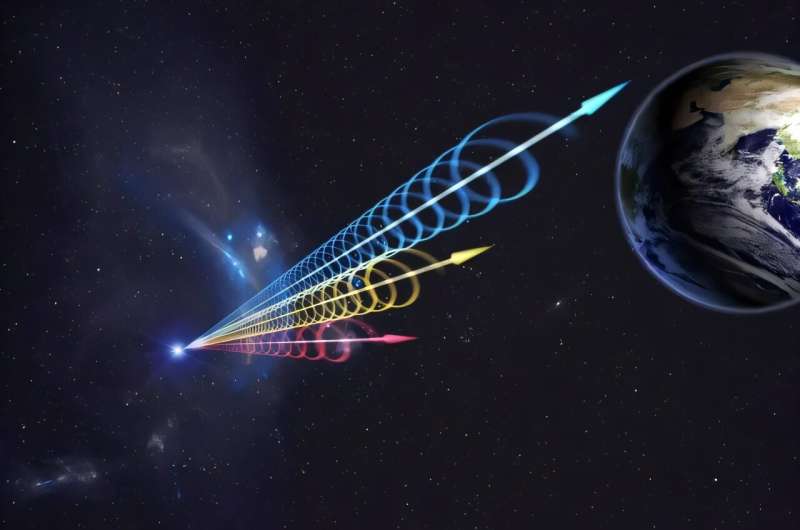Searching for pulsars using the Large Phased Array (LPA) radio telescope, Russian astronomers have detected a bright pulse at a frequency of 111 MHz, which appears to be a fast radio burst event. The finding was reported in a research paper published October 17 on the pre-print server arXiv.
Fast radio bursts (FRBs) are intense bursts of radio emission lasting milliseconds showcasing the characteristic dispersion sweep of radio pulsars. The physical nature of these bursts is yet unknown, and astronomers consider a variety of explanations ranging from synchrotron maser emission from young magnetars in supernova remnants to cosmic string cusps.
In general, FRBs are individual pulses with widths from 0.08 to 26 milliseconds and their dispersion measures usually range from 109 to 2,600 pc/cm3. Among the instruments capable of detecting pulses with such properties is LPA—one of the most sensitive radio telescopes operating at meter wavelengths.
Recently, a team of astronomers led by Sergey Tyul’bashev of the Pushchino Radio Astronomy Observatory in Russia, have detected an interesting pulse that may be an FRB. The discovery was made as part of the Pushchino Multibeams Pulsar Search (PUMPS) project, during a technical assessment of the quality of observations carried out with LPA of the Lebedev Physical Institute (LPI).
The discovered pulse lasted 211 milliseconds, had a dispersion measure of approximately 134.4 pc/cm3 and a peak flux density at a level of 20 Jy. The large dispersion measure of the pulse suggests its extragalactic origin and corresponds to a luminosity distance of about 2.3 billion light years.
According to the paper, the obtained properties indicate that the observed pulse is one of the most powerful fast radio bursts and the astronomers designated it FRB 20190203. The astronomers note that so far, no repeated radio bursts from FRB 20190203 have been detected, nor any activity has been observed in the gamma-ray range.
If the nature of FRB 20190203 is confirmed, it will make it the first burst of extragalactic origin discovered in the PUMPS survey. It is also the second FRB detected at such a low frequency (111 MHz), and the first one among non-repeating FRBs.
When it comes to the origin of FRB 20190203, the authors of the study propose the synchrotron maser emission scenario.
“In our opinion, the observed properties of FRB 20190203 are best explained by the model of a synchrotron maser source excited by a magnetar,” the researchers conclude.
More information:
S. A. Tyul’bashev et al, Pushchino multibeam pulsar search—V. The bright FRB 20190203 detected at 111 MHz, arXiv (2024). DOI: 10.48550/arxiv.2410.13561
Journal information:
arXiv
© 2024 Science X Network
Citation:
Astronomers discover a bright pulse that may be a fast radio burst (2024, October 24)
retrieved 24 October 2024
from https://phys.org/news/2024-10-astronomers-bright-pulse-fast-radio.html
This document is subject to copyright. Apart from any fair dealing for the purpose of private study or research, no
part may be reproduced without the written permission. The content is provided for information purposes only.

